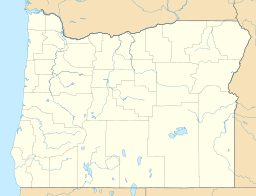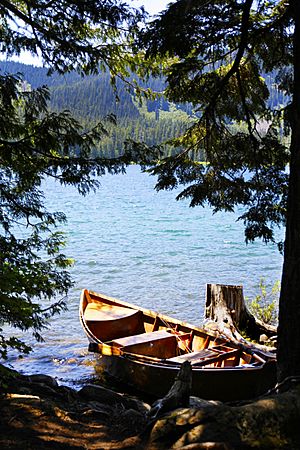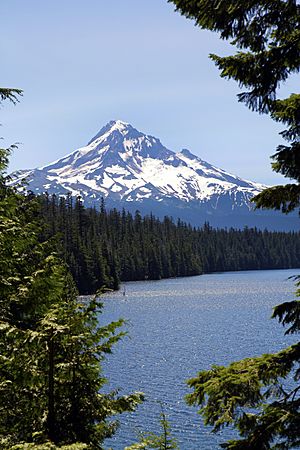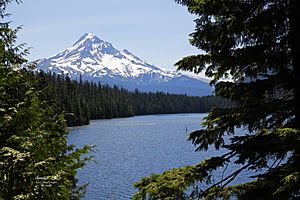Lost Lake (Hood River County, Oregon) facts for kids
Quick facts for kids Lost Lake |
|
|---|---|
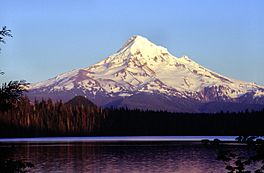
Famous View of Lost Lake, Mount Hood in the distance
|
|
| Location | Hood River County, Oregon, United States |
| Coordinates | 45°29′23″N 121°49′21″W / 45.489840°N 121.822578°W |
| Basin countries | United States |
| Max. length | 5,395 ft (1,644 m) |
| Max. width | 4,150 ft (1,260 m) |
| Surface area | 99.1 ha (245 acres) |
| Max. depth | 167 ft (51 m) |
| Surface elevation | 3,146 ft (959 m) |
| Frozen | occasionally |
| Islands | (none) |
| Settlements | (none) |
Lost Lake is a beautiful lake located in the Mount Hood National Forest in Oregon, United States. It's about 16 kilometers (10 miles) northwest of the famous Mount Hood. This makes it a great spot for enjoying nature and outdoor activities.
The lake is surrounded by tall mountains. To the east, you'll find Lost Lake Butte, and to the southwest is Preachers Peak. Water flows into the lake from these mountains through small creeks. Lost Lake keeps a steady water level because it has an outlet at its northern end. This outlet is the start of the Lake Branch Hood River. Lost Lake is also quite deep, reaching about 51 meters (167 feet) at its deepest point. It's the second-deepest lake in the Mount Hood National Forest!
Contents
Fun Things to Do at Lost Lake
Lost Lake is a very popular place for people to visit and have fun outdoors. It offers many ways to enjoy nature.
Camping and Staying Overnight
If you love camping, Lost Lake has 125 simple campsites. There are also seven cozy cabins you can rent. A small general store is available for your needs. The best time to visit is usually from May through October.
Boating and Water Activities
You can rent canoes, rowboats, and kayaks to explore the lake. It's a peaceful place because motorboats are not allowed. This helps keep the water calm and clean for everyone to enjoy. There is a small fee for vehicles entering the area for day use.
Amazing Animals and Plants
Lost Lake and the area around it are home to many different kinds of wildlife and plants.
Fish and Water Animals
The lake is full of various fish, including brook trout, brown trout, kokanee salmon, and rainbow trout. You might also spot crayfish, otters, and beavers swimming in the water or along the shore.
Land Animals and Trees
In the forests around the lake, you can see blacktail deer, squirrels, chipmunks, and rabbits. Sometimes, larger animals like black bears, cougars, and bobcats are also seen. The forest is mostly made up of tall Douglas fir and mountain hemlock trees. You'll also find some cedar and white pine. In open areas, there are alder bushes and huckleberry plants.
Protecting This Special Place
The area around Lost Lake is very important. It is part of a plan to create a special protected area called the Lewis and Clark Mount Hood Wilderness.
Why Protection Matters
If this area becomes a wilderness, it means it will be protected from new buildings, logging (cutting down trees), and mining. This helps keep the natural environment safe and beautiful for animals and plants, and for people to enjoy for many years to come.
A Look Back: Lost Lake's Story
Lost Lake has a rich history, especially with the Native American people who lived there long ago.
Native American Name
Native Americans had their own name for the lake: E-e-kwahl-a-mat-yam-lshkt. This beautiful name means "heart of the mountains."
How it Got the Name Lost Lake
The name "Lost Lake" came from a guide named Mack Hollamon. He was a hunting and fishing guide around the early 1900s. Even though he guided people all over Mount Hood, he didn't know about this lake until Native Americans showed him where it was. Because he had been "lost" to him for so long, he started calling it Lost Lake in his future tours. He also named other nearby lakes, like Dinger Lake and Frying Pan Lake.
Images for kids


